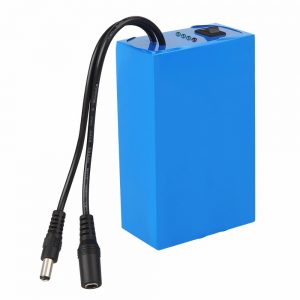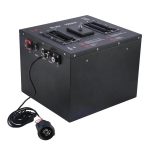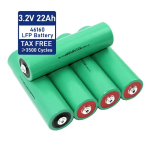
Lithium batteries have become a common part of our lives, and it’s not just in our electronic gadgets. By 2020, 55% of lithium-ion batteries sold are expected to be for the automotive industry.
The number of these batteries and their use in our everyday lives makes battery safety an important consideration. Here’s what you need to know about safety and lithium batteries.
Types of Lithium Batteries
Before going into battery safety, it helps to answer the question, “How do batteries work?
Lithium batteries operate by moving lithium ions between positive and negative electrodes. During discharge, the flow is from the negative electrode (or anode) to the positive electrode (or cathode), and vice versa when the battery is charging. The third major component of batteries are the electrolytes.
The most familiar type is the rechargeable lithium-ion battery. Some of these batteries have single cells, while others have multiple connected cells.
Battery safety, capacity, and usage are all impacted by how those cells are arranged, and which materials are used to make the battery components.
From a safety perspective, lithium iron phosphate (LiFePO4) batteries are more stable than other types. They can withstand higher temperatures, short circuits, and overcharging without combustion. This is important for any kind of battery, but especially ones for high power applications, such as an RV battery.
With that in mind, let’s look at ways of handling these batteries safely.
1: Stay Out of the Heat
Batteries operate best in temperatures that are also comfortable for people, around 20°C (68°F). You’ll still have plenty of lithium power at higher temperatures, but once you get past 40°C (104°F), the electrodes may start to degrade.
The exact temperature differs based on the type of battery. Lithium iron phosphate batteries can operate safely at 60°C (140°F), but even they will suffer problems after that.
If you’re using a device, such as a phone, with a lithium-ion battery, you won’t have much trouble keeping it out of those high temperatures.
For a vehicle or renewable energy system, though, it becomes more difficult, which is why it’s important to have a battery management system (BMS). The BMS protects the cells from getting damaged — most commonly from over or under-voltage, over-current, high temperature or external short-circuiting. The BMS will shut off the battery to protect the cells from unsafe operating conditions.
2: Avoid Sub-Freezing Temperatures
On the other extreme, operating and charging lithium batteries in cold weather also presents some challenges.
Batteries in temperatures below freezing (0°C or 32°F) don’t operate as well. If the temperature gets down to -4°C (-20°F), most batteries are only operating at 50% of their usual performance.
This is an important safety consideration if you’re driving an electric vehicle in cold temperatures since you don’t want to assume you can go your usual range. You’ll need to stop and recharge more often.
Charging batteries in cold weather, though, can also be problematic. When charging below freezing, plating forms on the anode of a lithium battery, and that plating can’t be removed. If this type of charging is done more than once, the battery will be more likely to fail if it suffers an impact.
For the best battery maintenance, wait to charge your battery until the temperatures are warm enough to avoid damage. ALL IN ONE also offers a Low-Temperature lithium battery that's designed specifically for cold weather charging
3: Safe Storage and Shipping
If you need to store or ship lithium batteries, the biggest concern is avoiding overheating, or what’s called thermal runaways. When this happens, the flammable electrolytes vaporize, and the reaction pressurizes the battery cells. If the case fails, the gases in the cells are released, leading to fire and possible explosion.
This is less likely with lithium iron phosphate batteries, but all lithium batteries are still considered hazardous when shipping.
Due to these concerns, air transportation has several restrictions on lithium batteries. Most can only be flown if the battery charge is 30% or less. Some can only be shipped on cargo aircraft, to protect passengers on commercial flights.
If you need to ship a lithium battery, and you can’t guarantee the charge level, you’ll need to use ground shipping.
From a storage perspective, overheating is still the main concern. You should discharge the battery to about 50% before long-term storage, and keep it within a comfortable temperature range, between 4°C and 27°C (40°F and 80°F).
You should also wear protective clothing when handling the batteries, in case they’re damaged. To help keep them stable, make sure they’re stored in a dry, well-ventilated place, and in a way that they won’t be knocked over.
4: Watch for Signs of Malfunction
Even if you’ve been handling your battery correctly, you should keep an eye out for any unusual signs. If you notice any unusual smells from your battery, or if it has changed shape or is behaving abnormally, you should disconnect it. If that’s not possible, move away from it and get help for handling it.
5: Leave Emergencies to the Professionals
In case of problems with the battery, especially with an electric vehicle, you shouldn’t try to deal with it yourself.
Problems with electric vehicles need to be handled differently than gas-powered vehicles. Fires from batteries can last for a long time, up to 24 hours, and putting them out requires up to 3,000 gallons of water.
In addition to being flammable, a damaged lithium battery could leak, and both the spilled material and the gases are dangerous. Anyone who has come into contact with the material should seek medical help.
This doesn’t mean that electric vehicles, like your battery-powered RV, are more dangerous than other vehicles. You simply don’t want to make the mistake of thinking you can handle emergencies by yourself.
Proper Lithium Battery Safety Will Keep You Going
Lithium batteries are very safe overall, but you should still follow battery safety tips. If you do, you can relax and enjoy using your battery for years to come.
Interested in learning more about lithium iron phosphate batteries? Contact us today, and one of our battery pros will be in touch with you shortly.


